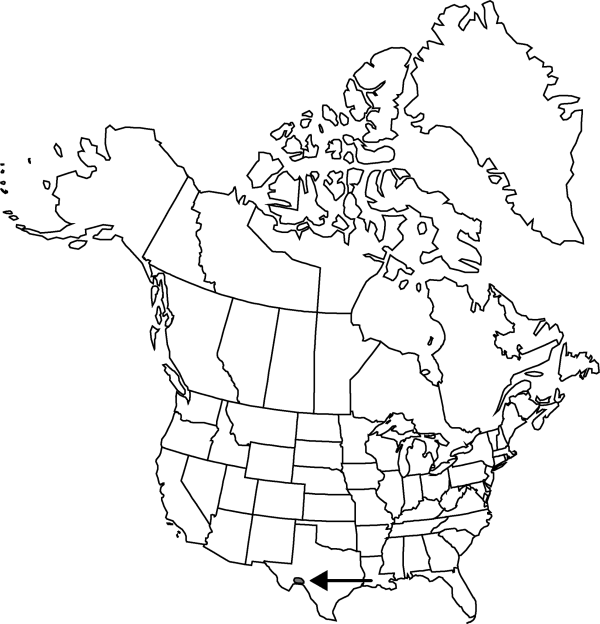Difference between revisions of "Echinocereus pectinatus var. wenigeri"
Cact. Succ. J. (Los Angeles) 40: 124, fig. 3. 1968.
FNA>Volume Importer |
FNA>Volume Importer |
||
| Line 17: | Line 17: | ||
}}<!-- | }}<!-- | ||
| − | --><span class="statement" id="st- | + | --><span class="statement" id="st-undefined" data-properties=""><b>Plants </b>unbranched or few branched from near base in old age. <b>Stems</b> erect, short cylindric or sometimes spheric, 8–17(–25) × 5.6–8(–10) cm; ribs (13–)14–18, crests slightly undulate; areoles 4–15 mm apart. <b>Spines</b> (14–)17–26(–31) per areole, straight, tightly appressed (radial spines) or strongly projecting (central spines), presenting smooth general aspect to plant, ashy white, never pink, largest spines tipped purplish brown, annual growth increments not marked by rings of different color; radial spines (13–)15–24(–26) per areole, 7–10(–13) mm; central spines (1–)2–6(–7) per areole, short, inconspicuous, nearly terete, (2.2–)4–6 mm. <b>Flowers</b> 7–9(–11) × (5–)5.5–10(–13) cm; flower tube 10–15 × 15–25 mm; flower tube hairs 2–3(–5) mm; inner tepals often stiffly ascending, pink or magenta, white in proximal 1/2, green near base (distal colored portion varying greatly in extent), 34–62 × 7–19 mm, tips relatively thin and delicate; anthers yellow; nectar chamber 2–6 mm. <b>Fruits</b> dark purplish, 25–30 mm, pulp white to pink. <b>2n</b> = 22.</span><!-- |
-->{{Treatment/Body | -->{{Treatment/Body | ||
| + | |phenology=Flowering Mar–May; fruiting May–Jul. | ||
|habitat=Tamaulipan thorn scrub, degraded grasslands, often with Juniperus pinchotii, Chihuahuan desert scrub, limestone outcrops | |habitat=Tamaulipan thorn scrub, degraded grasslands, often with Juniperus pinchotii, Chihuahuan desert scrub, limestone outcrops | ||
|elevation=300-900[-1700] m | |elevation=300-900[-1700] m | ||
| Line 39: | Line 40: | ||
|basionyms= | |basionyms= | ||
|family=Cactaceae | |family=Cactaceae | ||
| + | |phenology=Flowering Mar–May; fruiting May–Jul. | ||
|habitat=Tamaulipan thorn scrub, degraded grasslands, often with Juniperus pinchotii, Chihuahuan desert scrub, limestone outcrops | |habitat=Tamaulipan thorn scrub, degraded grasslands, often with Juniperus pinchotii, Chihuahuan desert scrub, limestone outcrops | ||
|elevation=300-900[-1700] m | |elevation=300-900[-1700] m | ||
| Line 46: | Line 48: | ||
|publication year=1968 | |publication year=1968 | ||
|special status= | |special status= | ||
| − | |source xml=https://jpend@bitbucket.org/aafc-mbb/fna- | + | |source xml=https://jpend@bitbucket.org/aafc-mbb/fna-data-curation.git/src/9216fc802291cd3df363fd52122300479582ede7/coarse_grained_fna_xml/V4/V4_313.xml |
|subfamily=Cactaceae subfam. Cactoideae | |subfamily=Cactaceae subfam. Cactoideae | ||
|genus=Echinocereus | |genus=Echinocereus | ||
|species=Echinocereus pectinatus | |species=Echinocereus pectinatus | ||
|variety=Echinocereus pectinatus var. wenigeri | |variety=Echinocereus pectinatus var. wenigeri | ||
| − | |||
| − | |||
| − | |||
| − | |||
| − | |||
| − | |||
| − | |||
| − | |||
| − | |||
| − | |||
| − | |||
| − | |||
| − | |||
| − | |||
| − | |||
| − | |||
| − | |||
| − | |||
| − | |||
| − | |||
| − | |||
| − | |||
| − | |||
| − | |||
| − | |||
| − | |||
| − | |||
| − | |||
| − | |||
| − | |||
| − | |||
| − | |||
| − | |||
| − | |||
| − | |||
| − | |||
| − | |||
| − | |||
| − | |||
| − | |||
| − | |||
| − | |||
| − | |||
| − | |||
| − | |||
| − | |||
| − | |||
| − | |||
| − | |||
| − | |||
| − | |||
| − | |||
}}<!-- | }}<!-- | ||
-->[[Category:Treatment]][[Category:Echinocereus pectinatus]] | -->[[Category:Treatment]][[Category:Echinocereus pectinatus]] | ||
Revision as of 14:05, 27 July 2019
Plants unbranched or few branched from near base in old age. Stems erect, short cylindric or sometimes spheric, 8–17(–25) × 5.6–8(–10) cm; ribs (13–)14–18, crests slightly undulate; areoles 4–15 mm apart. Spines (14–)17–26(–31) per areole, straight, tightly appressed (radial spines) or strongly projecting (central spines), presenting smooth general aspect to plant, ashy white, never pink, largest spines tipped purplish brown, annual growth increments not marked by rings of different color; radial spines (13–)15–24(–26) per areole, 7–10(–13) mm; central spines (1–)2–6(–7) per areole, short, inconspicuous, nearly terete, (2.2–)4–6 mm. Flowers 7–9(–11) × (5–)5.5–10(–13) cm; flower tube 10–15 × 15–25 mm; flower tube hairs 2–3(–5) mm; inner tepals often stiffly ascending, pink or magenta, white in proximal 1/2, green near base (distal colored portion varying greatly in extent), 34–62 × 7–19 mm, tips relatively thin and delicate; anthers yellow; nectar chamber 2–6 mm. Fruits dark purplish, 25–30 mm, pulp white to pink. 2n = 22.
Phenology: Flowering Mar–May; fruiting May–Jul.
Habitat: Tamaulipan thorn scrub, degraded grasslands, often with Juniperus pinchotii, Chihuahuan desert scrub, limestone outcrops
Elevation: 300-900[-1700] m
Distribution

Tex., Mexico (Coahuila).
Discussion
Plants of Echinocereus pectinatus var. wenigeri are entirely whitish in aspect, without the conspicuous annual color banding characteristic of other “rainbow cacti” and without the gloss, luster, or translucency generally perceived in fresh spines. Without flowers or fruits, this variety is easily misidentified as E. reichenbachii, with which it sometimes grows sympatrically. Echinocereus pectinatus has white-centered flowers (with green throats, forming a target pattern) whereas E. dasyacanthus flowers, irrespective of color form, have only the greenish throats and no white bands on the inner tepals.
Selected References
None.